If you were asked to name three key components of Microsoft Excel, what would they be? Most likely, spreadsheets to input data, formulas to perform calculations and charts to create graphical representations of various data types.
I believe, every Excel user knows what a chart is and how to create it. However, one graph type remains opaque to many - the Gantt chart. This short tutorial will explain the key features of the Gantt diagram, show how to make a simple Gantt chart in Excel, where to download advanced Gantt chart templates and how to use the online Project Management Gantt Chart creator.
What is a Gantt chart?
The Gantt chart bears a name of Henry Gantt, American mechanical engineer and management consultant who invented this chart as early as in 1910s. A Gantt diagram in Excel represents projects or tasks in the form of cascading horizontal bar charts. A Gantt chart illustrates the breakdown structure of the project by showing the start and finish dates as well as various relationships between project activities, and in this way helps you track the tasks against their scheduled time or predefined milestones.

How to make Gantt chart in Excel
Regrettably, Microsoft Excel does not have a built-in Gantt chart template as an option. However, you can quickly create a Gantt chart in Excel by using the bar graph functionality and a bit of formatting.
Please follow the below steps closely and you will make a simple Gantt chart in under 3 minutes. We will be using Excel 2010 for this Gantt chart example, but you can simulate Gantt diagrams in any version of Excel 2013 through Excel 365 in the same way.
1. Create a project table
You start by entering your project's data in an Excel spreadsheet. List each task is a separate row and structure your project plan by including the Start date, End date and Duration, i.e. the number of days required to complete the tasks.
Tip. Only the Start date and Duration columns are necessary for creating an Excel Gantt chart. If you have Start Dates and End Dates, you can use one of these simple formulas to calculate Duration, whichever makes more sense for you:
Duration = End Date - Start Date
Duration = End date - Start date + 1
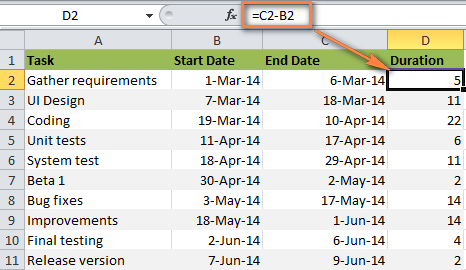
2. Make a standard Excel Bar chart based on Start date
You begin making your Gantt chart in Excel by setting up a usual Stacked Bar chart.
- Select a range of your Start Dates with the column header, it's B1:B11 in our case. Be sure to select only the cells with data, and not the entire column.
- Switch to the Insert tab > Charts group and click Bar.
- Under the 2-D Bar section, click Stacked Bar.

As a result, you will have the following Stacked bar added to your worksheet:
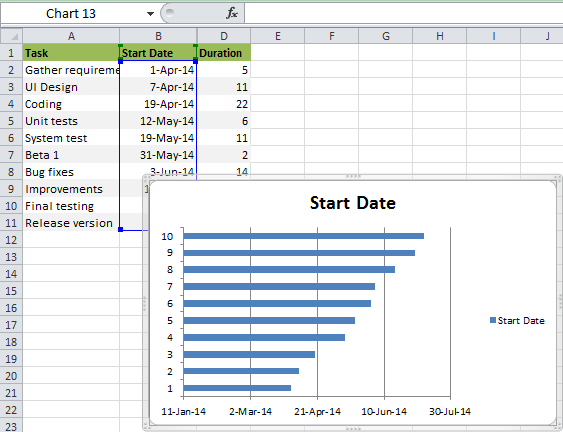
Note. Some other Gantt Chart tutorials you can find on the web recommend creating an empty bar chart first and then populating it with data as explained in the next step. But I think the above approach is better because Microsoft Excel will add one data series to the chart automatically, and in this way save you some time.
3. Add Duration data to the chart
Now you need to add one more series to your Excel Gantt chart-to-be.
- Right-click anywhere within the chart area and choose Select Data from the context menu.
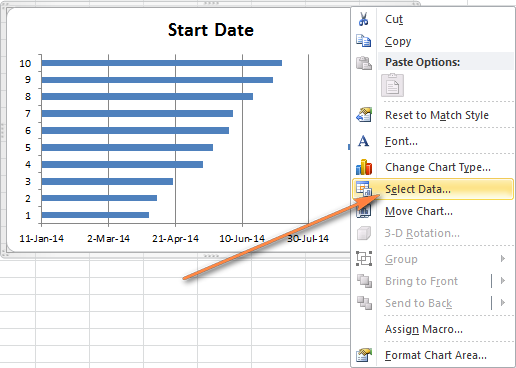 The Select Data Source window will open. As you can see in the screenshot below, Start Date is already added under Legend Entries (Series). And you need to add Duration there as well.
The Select Data Source window will open. As you can see in the screenshot below, Start Date is already added under Legend Entries (Series). And you need to add Duration there as well. - Click the Add button to select more data (Duration) you want to plot in the Gantt chart.
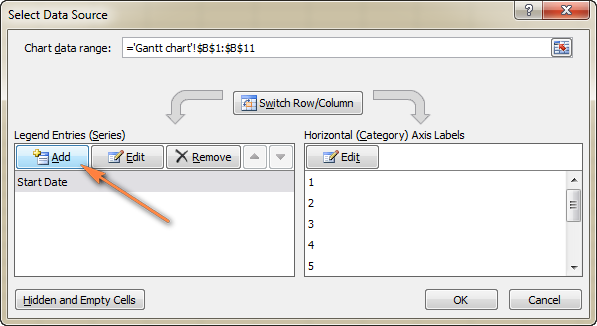
- The Edit Series window opens and you do the following:
- In the Series name field, type "Duration" or any other name of your choosing. Alternatively, you can place the mouse cursor into this field and click the column header in your spreadsheet, the clicked header will be added as the Series name for the Gantt chart.
- Click the range selection icon
 next to the Series Values field.
next to the Series Values field.

- A small Edit Series window will open. Select your project Duration data by clicking on the first Duration cell (D2 in our case) and dragging the mouse down to the last duration (D11). Make sure you have not mistakenly included the header or any empty cell.
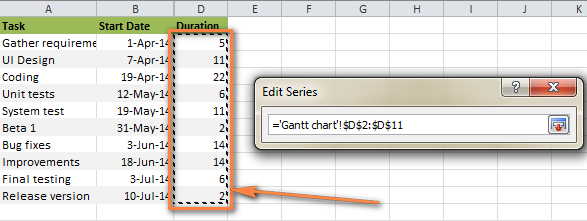
- Click the Collapse Dialog icon to exit this small window. This will bring you back to the previous Edit Series window with Series name and Series values filled in, where you click OK.
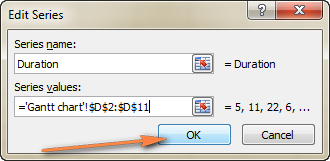
- Now you are back at the Select Data Source window with both Start Date and Duration added under Legend Entries (Series). Simply click OK for the Duration data to be added to your Excel chart.
 The resulting bar chart should look similar to this:
The resulting bar chart should look similar to this:
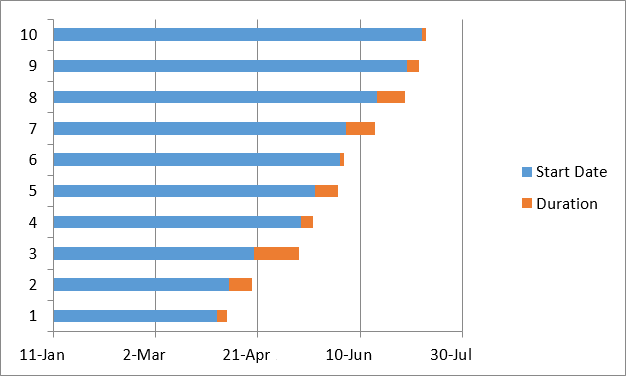
4. Add task descriptions to the Gantt chart
Now you need to replace the days on the left side of the chart with the list of tasks.
- Right-click anywhere within the chart plot area (the area with blue and orange bars) and click Select Data to bring up the Select Data Source window again.
- Make sure the Start Date is selected on the left pane and click the Edit button on the right pane, under Horizontal (Category) Axis Labels.

- A small Axis Label window opens and you select your tasks in the same fashion as you selected Durations in the previous step - click the range selection icon
 , then click on the first task in your table and drag the mouse down to the last task. Remember, the column header should not be included. When done, exit the window by clicking on the range selection icon again.
, then click on the first task in your table and drag the mouse down to the last task. Remember, the column header should not be included. When done, exit the window by clicking on the range selection icon again.

- Click OK twice to close the open windows.
- Remove the chart labels block by right-clicking it and selecting Delete from the context menu.
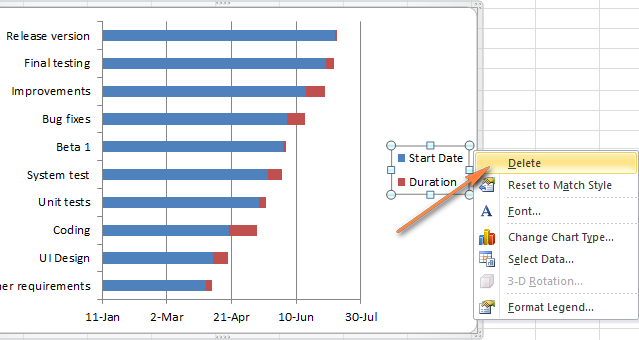 At this point your Gantt chart should have task descriptions on the left side and look something like this:
At this point your Gantt chart should have task descriptions on the left side and look something like this:
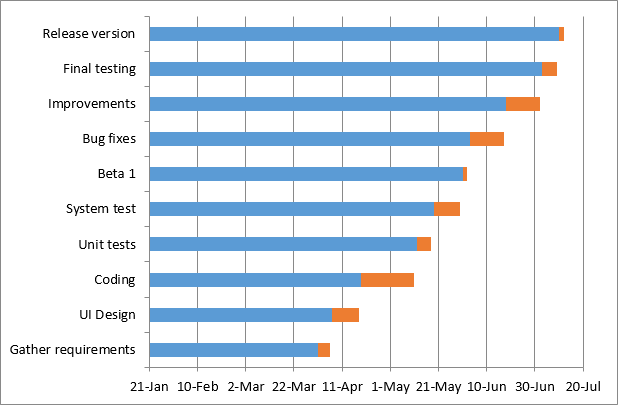
5. Transform the bar graph into the Excel Gantt chart
What you have now is still a stacked bar chart. You have to add the proper formatting to make it look more like a Gantt chart. Our goal is to remove the blue bars so that only the orange parts representing the project's tasks will be visible. In technical terms, we won't really delete the blue bars, but rather make them transparent and therefore invisible.
- Click on any blue bar in your Gantt chart to select them all, right-click and choose Format Data Series from the context menu.
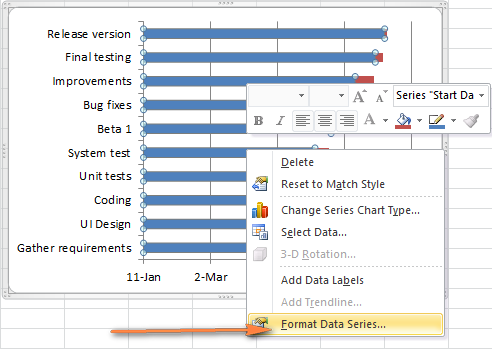
- The Format Data Series window will show up and you do the following:
- Switch to the Fill tab and select No Fill.
- Go to the Border Color tab and select No Line.

Note. You do not need to close the dialog because you will use it again in the next step.
- As you have probably noticed, the tasks on your Excel Gantt chart are listed in reverse order. And now we are going to fix this.Click on the list of tasks in the left-hand part of your Gantt chart to select them. This will display the Format Axis dialog for you. Select the Categories in reverse order option under Axis Options and then click the Close button to save all the changes.
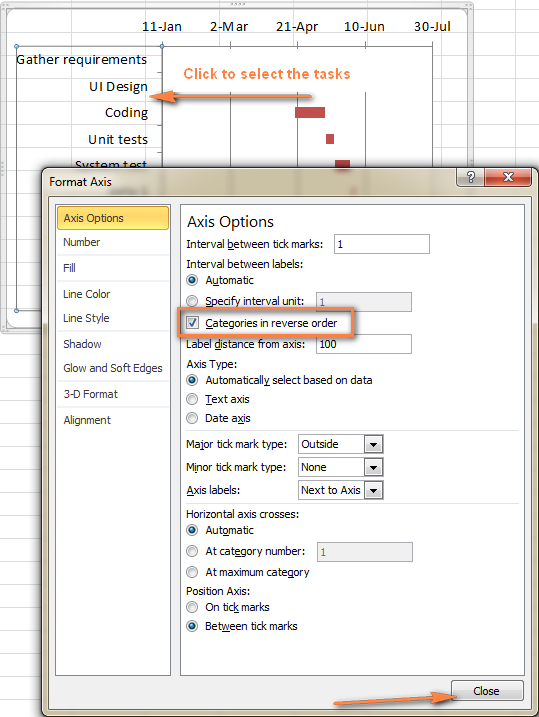
The results of the changes you have just made are:
- Your tasks are arranged in a proper order on a Gantt chart.
- Date markers are moved from the bottom to the top of the graph.
Your Excel chart is starting to look like a normal Gantt chart, isn't it? For example, my Gantt diagram looks like this now:

6. Improve the design of your Excel Gantt chart
Though your Excel Gantt chart is beginning to take shape, you can add a few more finishing touches to make it really stylish.
- Remove the empty space on the left side of the Gantt chart.As you remember, originally the starting date blue bars resided at the start of your Excel Gantt diagram. Now you can remove that blank white space to bring your tasks a little closer to the left vertical axis.
- Right-click on the first Start Date in your data table, select Format Cells > General. Write down the number that you see - this is a numeric representation of the date, in my case 41730. As you probably know, Excel stores dates as numbers based on the number of days since 1-Jan-1900. Click Cancel because you don't actually want to make any changes here.
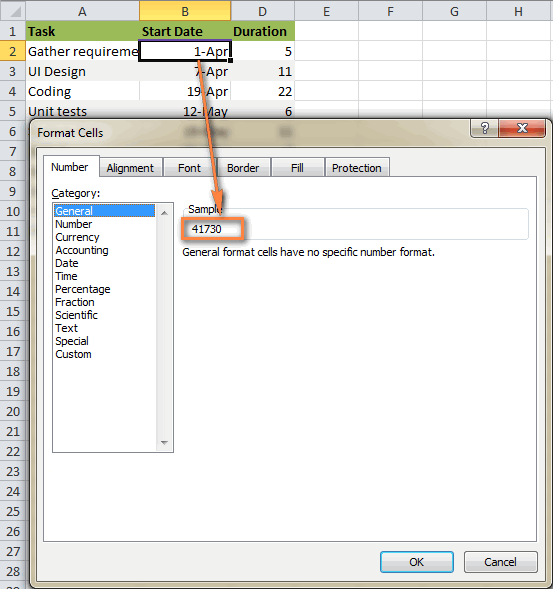
- Click on any date above the task bars in your Gantt chart. One click will select all the dates, you right click them and choose Format Axis from the context menu.
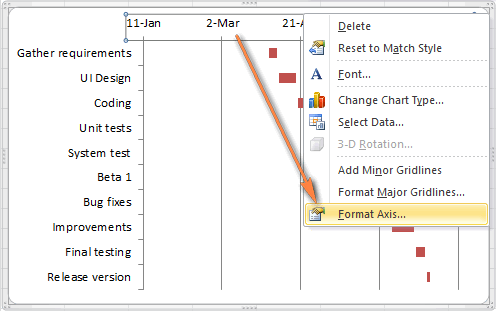
- Under Axis Options, change Minimum to Fixed and type the number you recorded in the previous step.
- Right-click on the first Start Date in your data table, select Format Cells > General. Write down the number that you see - this is a numeric representation of the date, in my case 41730. As you probably know, Excel stores dates as numbers based on the number of days since 1-Jan-1900. Click Cancel because you don't actually want to make any changes here.
- Adjust the number of dates on your Gantt chart. In the same Format Axis window that you used in the previous step, change Major unit and Minor unit to Fixed too, and then add the numbers you want for the date intervals. Typically, the shorter your project's timeframe is, the smaller numbers you use. For example, if you want to show every other date, enter 2 in the Major unit. You can see my settings in the screenshot below.
Note. In Excel 365, Excel 2021 - 2013, there are no Auto and Fixed radio buttons, so you simply type the number in the box.

Tip. You can play with different settings until you get the result that works best for you. Don't be afraid to do something wrong because you can always revert to the default settings by switching back to Auto in Excel 2010 and 2007, or click Reset in Excel 2013 and later.
- Remove excess white space between the bars. Compacting the task bars will make your Gantt graph look even better.
- Click any of the orange bars to get them all selected, right click and select Format Data Series.
- In the Format Data Series dialog, set Separated to 100% and Gap Width to 0% (or close to 0%).

And here is the result of our efforts - a simple but nice-looking Excel Gantt chart:
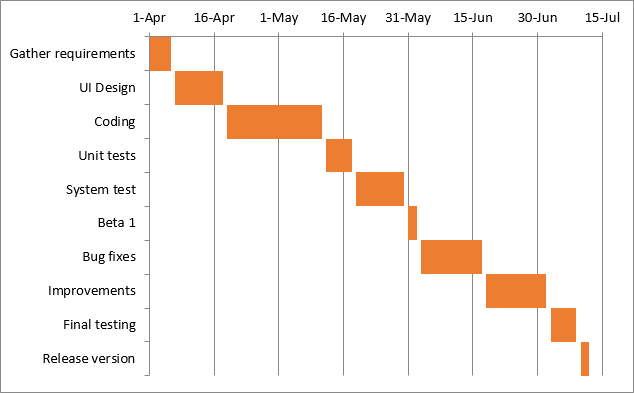
Remember, though your Excel chart simulates a Gantt diagram very closely, it still keeps the main features of a standard Excel chart:
- Your Excel Gantt chart will resize when you add or remove tasks.
- You can change a Start date or Duration, the chart will reflect the changes and adjust automatically.
- You can save your Excel Gantt chart as an image or convert to HTML and publish online.
Tips:
- You can design your Excel Gant chart in different ways by changing the fill color, border color, shadow and even applying the 3-D format. All these options are available in the Format Data Series window (right-click the bars in the chart area and select Format Data Series from the context menu).

- When you have created an awesome design, it might be a good idea to save your Excel Gantt chart as a template for future use. To do this, click the chart, switch to the Design tab on the ribbon and click Save as Template.
Excel Gantt chart templates
As you see, it's not a big problem to build a simple Gantt chart in Excel. But what if you want a more sophisticated Gantt diagram with percent-complete shading for each task and a vertical Milestone or Checkpoint line? Of course, if you are one of those rare and mysterious creatures whom we respectively call "Excel gurus", you can try to make such a graph on your own, with the help of this article: Advanced Gantt Charts in Microsoft Excel.
However, a faster and more stress-free way would be using an Excel Gantt chart template. Below you will find a quick overview of several project management Gantt chart templates for different versions of Microsoft Excel.
Gantt chart template for Microsoft Excel
This Excel Gantt chart template, called Gantt Project Planner, is purposed to track your project by different activities such as Plan Start and Actual Start, Plan Duration and Actual Duration as well as Percent Complete.
In Excel 2013 - 2021, just go to File > New and type "Gantt" in the Search box. If you cannot find it there, you can download it from Microsoft's web-site - Gantt Project Planner template. This template requires no learning curve at all, simply click on it and it's ready for use.
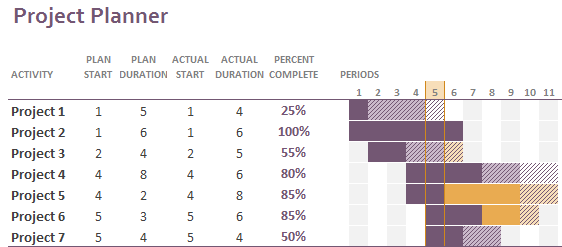
Online Gantt chart template
This is an Interactive Online Gantt Chart Creator from smartsheet.com. As well as the previous Gantt chart template, this one is fast and easy-to-use. They offer 30 days free trial, so you can sign with your Google account here and start making your first Excel Gantt diagram online straight away.
The process is very straightforward, you enter your project details in the left-hand table, and as you type a Gantt Chart is being built in the right-hand part of the screen.
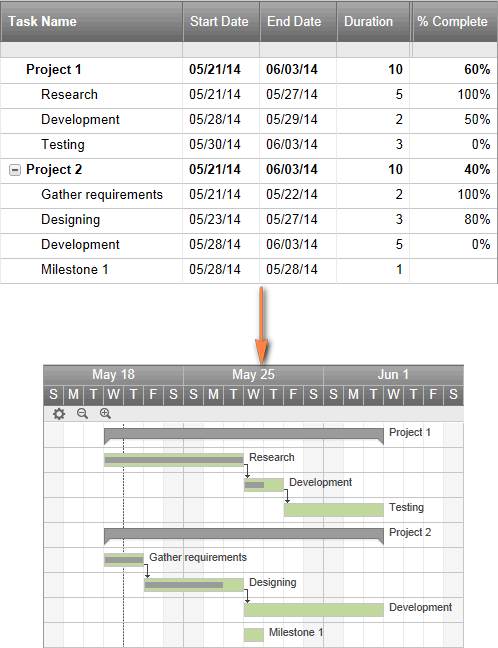
Gantt chart template for Excel, Google Sheets and OpenOffice Calc
Gantt chart template from vertex42.com is a free Gantt chart template that works with Excel as well as OpenOffice Calc and Google Sheets. You work with this template in the same fashion as you do with any normal Excel spreadsheet. Simply enter the start date and duration for each task and define % in the Complete column. To change the range of dates displayed in the Gantt chart area, slide the scroll bar.
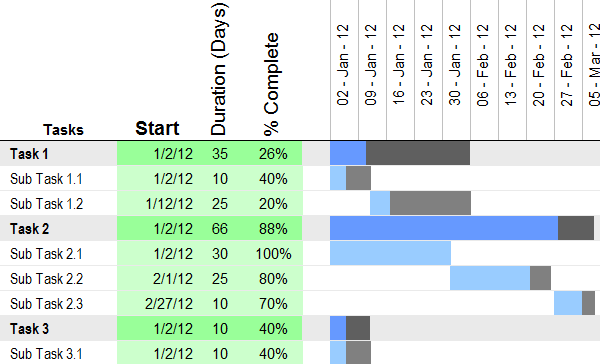
And finally, one more Gant chart Excel template for your consideration.
Project Manager Gantt Chart template
Project Manager Gantt Chart from professionalexcel.com is also a free project management Gantt chart template for Excel that can help track your tasks against their allocated time. You can choose either the standard weekly view or daily for short term projects.
Hopefully, at least one of the above-mentioned templates is suited for your needs. If not, you can create your own Gantt chart as demonstrated in the first part of this tutorial, and then save it as an Excel template.
Now that you are familiar with the main features of the Gantt diagram, you can explore it further and create your own sophisticated Gantt charts in Excel to amaze your boss and co-workers : )
Practice workbook for download
Gantt chart example (.xlsx file)
 by
by
426 comments
Hi there,
My current gantt is entered in days. How can I change that to reflect weeks?
Please respond urgently
Thank you
try exiting in weeks. so it will reflect the weeks that you have wasted.
I am trying to create a Gantt Chart or another chart that will display multiple items across the same line over about a five year period. The months need to be able to be expanded to display the days of the month as well so the start and end dates of each data point can be displayed when needed. is there a template already made that will capture data in this manner?
Thank you,
James
Hi James,
I think going from a five year view to a day view will surpass excels capabilities. I myself used to make gantts in excel but I said enough. I came to this comment section because I used to do this.
I want to understand more about how people are using gantts and why, to build an easier way to do them. No selling. Just want to learn more to build the right thing.
Are you up for a 20 min chat?
Adrian.
Hi,
I was wondering whether its possible to include the "Work done by" column also to be included in the chart. becasue since various works are done by different personals of the company, it would be better.
Thank you for your support
Hi,
I was wondering whether itspossible to inlude the "Work done by" column also to be included in the chart. Cz sincevarious works are done by different personals of the company, it would be better.
Thank you for your support
Simple Approach and clear cut examples. Thanks
Great walk-through, thank you! Now I would like to take the chart and make it a separate tab.
Thank you very much for a very nice tutorial on the topic. Really grateful to you!
How can I used number of days instead of dates? Starting from day 1 to day 100 for example. and can I also have a one line instead of stack bar? on the line it is has the days from 1 to 100. Thanks. I will appreciate the help.
Hi - I can't see anything saying 'fixed' in format axis -is it the version im using? its excel 2016 - Thanks
Hi Lottie,
In Excel 2013 and Excel 2016, are no Auto and Fixed radio buttons, so you simply type the number in the box.
This was really helpful. Thanks a lot
Re the above comment- sorry ignore the gaps example its selecting fixed axis options that is the problem for me in 2016 :)
Hi Andrew,
In Excel 2013 and Excel 2016, are no Auto and Fixed radio buttons, and you simply type the number in the box to make a certain unit fixed.
I've added this note to the tutorial, thanks for pointing it out!
Really nice tutorial - thank you.
However Excel 2016 has a few changes (like closing the gap between bars) - any chance of an update for this version?
Hi - I am trying to add an item but it is not accepting this when i go to my select data - how do i add my tasks to include them in my gant chart? :-(
Very nice.
Great article, spot on. Thanks for sharing.
I will be using your tips, n this will help me save a lot of time... Thank you very much.
thanks
How can I add same repeated task at different dates in Gantt chart??
This is the most helpful site across the entire internet to make a Gantt Chart. However, today I stumbled on some software that not many are familiar with - Microsoft Project... This looks like something that should be in the Microsoft Office Suite but it is somehow sold separately... Really easy to use... just feed data and it creates a Gantt Chart with additional details like who is to perform the task, how many hours they take, amount of resources used etc. But this site is just super...
can anyone please help me?
I need to make a gantt chart for the process unavailability in my plant. The shift starts at 8am and ends at 8am on the next day. And there are some 10 process which have their individual break downs. How to make the chart using time as horizontal series?
Hi, I want to show Gantt Chart in Time, The date will be same for all the task/project but for the same date I want different time duration not the days.
excellent
Good day to you!
I am trying to draw up a Gantt Chart for different building tasks, meaning building trailers, from obtaining the drawings, material, cutting, up to completion... However, I need to block out (stop the next person to be able to enter) the next task-starting date to ensure that the first task is completed 100% before the next task-starting-date may be entered. In other words, the cell must be "unlocked" by the previous "% completion" cell information. Please can someone tell me how to do this?
Good Day to you :)
I was able to drew Gantt Chart for my school project, after learning from your instructions. However, the dates on the chart displayed on the chart is totally different from the ones I had created on the list. Will you be able to advice me?
Thank you and with warmest regards,
Nay Lin
I am stuck on point 6. I am using Excel 2013 and when I click on Format Axis under 'Axis Options' there is no 'Fixed' options to change to. Only min & max. Please can you help?
Can you please help? I have been trying for hours to make the tasks names closer together, as there is a huge gap, in between. Have tried in Format Data Series but there does not seem to be an option there that will allow me to edit (it is greyed out). I have Excel 2013, so options shown above aren't necessarily the same.
it's all good, just figured it out.
when i tried to select the data, it only shows 'sheet1'!.....whereas in your sample if I click select data it will show 'Ghantt'!. why is so?
Hi Pema,
'sheet1'! is just the name of the sheet where you are selecting data. In my sample workbook, I named the sheet "Gantt chart" and therefore you see this name.
Thank you VERY much for this tutorial. At first I wanted to give up since it looked difficult to me but I followed it step by step and it was very easy to follow because it is well explained.
I have been able to edit a Gannt template into a 2 year construction schedule that has as many as 200+ tasks in rows and dates are shown in columns. Conditional formatting highlights dates and progress of each task. I have frozen panes at cell I-10 to maintain tasks on the left and dates across the top.
I have created a lookup cell where you can enter a date in that highlights the proposed start of a 3 week look-ahead schedule.
My 1st issue is when I enter the date to begin my 3 week schedule; it will highlight the proper beginning date column as desired, but I have to manually scroll over to the highlighted column to view the date (potentially 500+ columns to the right). I want Excel to automatically scroll the highlighted start date column to the left; (within viewing area) beside column ‘H’.
My 2nd issue is that I want to be able to print just the 3 week schedule and frozen panes starting on the highlighted column (basically print the same thing I see on the screen) and down to the bottom of active task rows (this could be as few as 10 and as many as 200 rows).
I have been able to highlight the cells I want to print and use the “print Selection” printer option as an elementary work around, however I have been unsuccessful in accomplishing the dynamic print issue with the a function or command. I may not have the correct format or function. Is it possible to accomplish this and can you lead me in the right direction?
Thanks!
Good stuff here. Am on it let me see what I will come up with definitely its a gannt chart but I would really love it to resemble the tutor's.
Madam,
Thanks a lot for nice article with clear understanding,
In addition it is requested to further inform about plotting in single line with different colours instead of steps (as above gantt steps) possible with excel chart commands (not with VBA codes).
Thank you so much for this tutorial! But I see the milestones on the first image. Could you please describe how to add a few simple milestone to the same gantt chart?
Completing a research proposal for my MSc and this made it easy and pretty straight forward to produce a timing plan. Thanks!!
thanks for a clear explanation
I tried setting up the date axis but couldn't select the "fixed" option under part 6.2. I'm using Excel for Mac.
Hi Gregg,
In Excel for Mac there are no Auto and Fixed radio buttons, so you simply type the number in the box.
Brilliant article and I recreated the Gantt easily. How did you ever figure this out!
Thanks for publishing this as I will be using this method quite regularly!
Great works,
i have query that i want make a gantt chart where i can track a multiple work done by person on Minute Scale.And Works are over lapping to each other in time frame.
Please help
Thanks in Advance
Hello, Karan,
Please try to count duration in minutes. Hope this helps.
Wow!!! I am so glad I found your site; my gantt chart looks amazing. Thanks to you, I received many kudos. Thanks again Svetlana!
Thanks. Can I add or mirror the dates to the top and bottom of the gantt chart?
Very nice tutorial Svetlana!
Thanks
Stuart
This is great, but would love to place a line onto the chart for critical path. I've tried adding an XY with lines, but Excel2013 keeps applying secondary axis and greys it out so you can't change. Any ideas ?
How can I add a Milestone?
BEST and easiest to follow instructions I found. Thank you!
Very good tutorial. thanks you for sharing.
1 question : I nee to display teh date format in a specific format : weekly YY-WW example 15W49
I face issue as it seems that graph is based on serial number only...(excel 2010)
Have you the trick to solve this?
Hi
I'm trying to get the months to show on the horizontal axis the entire month ie 1- 30 April in one block, with solid line at the start and at the end of the month, but instead solid line appears in the middle of the month.
How do you fix this? I've tried formatting the axis.
Thank you
Hello, I have used this chart, but I have added the "workday" function with a list of holidays. How do I make the duration bar actually represent the true duration with weekends and holidays included?
Is it possible to label the bars with task names in the gnatt chart above ? Thx.
The task names are retrieved from the source data. As soon as you change the names in your worksheet, the Gantt chat will reflect the changes.
I need to make a gantt chart for the process unavailability in my plant. The shift starts at 8am and ends at 8am on the next day. And there are some 10 process which have their individual break downs. How to make the chart using time as horizontal series?
When using the Project Planner Template in Excel, can the periods be changed to dates? I've tried to change them via formatting and that is not an issue, however it pushes back all of the percentages complete (at least by a month) that I've already input. It also changes those from actual to beyond plan on my spreadsheet.
Hi,
Is it possible to display date and time on the Gantt chart? I have to display a schedule of classes that will take place over a period of 6 weeks.Each class is 1 hour long and there are total of 27 classes.
Thanks
Hello, I was following your step by steps, and I keep running into the same problem.. When I go to add duration to the data, it says that the chart is to complex and if I add the second set of data the first will be deleted.. I don't understand why. Any help would be great. Thanks